If your Shopify store is suffering from low sales, you must be looking for ideal tactics to increase them.
Paid advertising may be a great way to boost sales; however, it is not an ideal strategy in the long run, given the increased usage of ad blockers and new privacy laws.
So, how to get shopify sales without investing in paid advertising? Here are 11 practical strategies.
Why Your Shopify Store is Not Getting Sales
Before jumping into the tips on how to get more sales on Shopify, it is important to know why you aren’t getting sales on your online store in the first place.
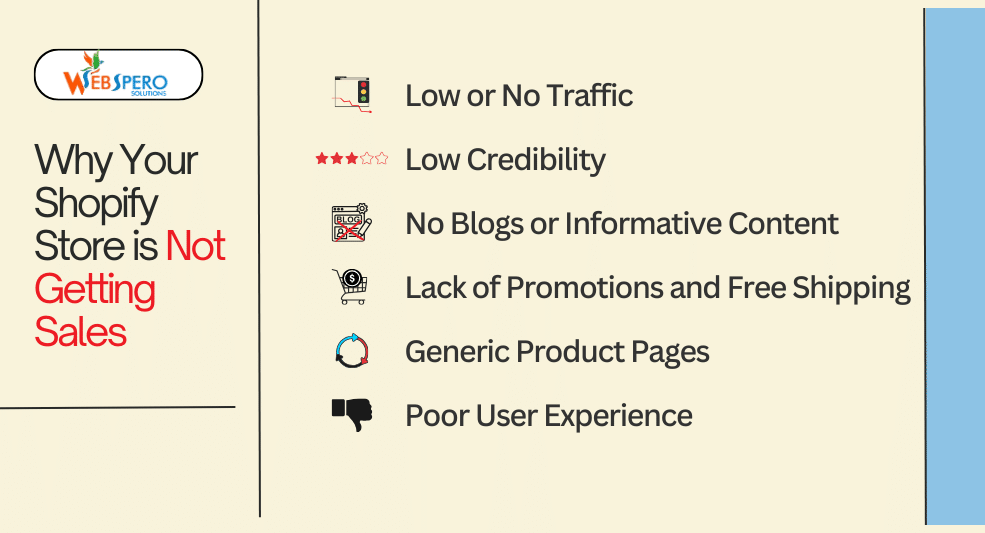
Low or No Traffic
This is one of the primary reasons why you aren’t getting any sales. Because if no one’s visiting your online store, nobody’s going to buy anything. If you’re looking to boost traffic on your eCommerce website, here’s how to do it.
Low Credibility
Users are very likely to abandon carts if they find your store untrustworthy. So, make sure you’re adding trust signals to your checkout page.
No Blogs or Informative Content
Specifically for your online store, blogs should be written as a guide, which helps your customers understand how it solves a problem, boosting your sales.
Lack of Promotions or Free Shipping
Even if it is a small incentive, people want it. Not having any kind of promotions like free shipping or a specific discount can deter customers from completing their purchases. In fact, 70% of carts get abandoned due to unexpected shipping costs and other fees.
Interestingly, 70% of customers in the US claim that free shipping is the reason why they shop online.
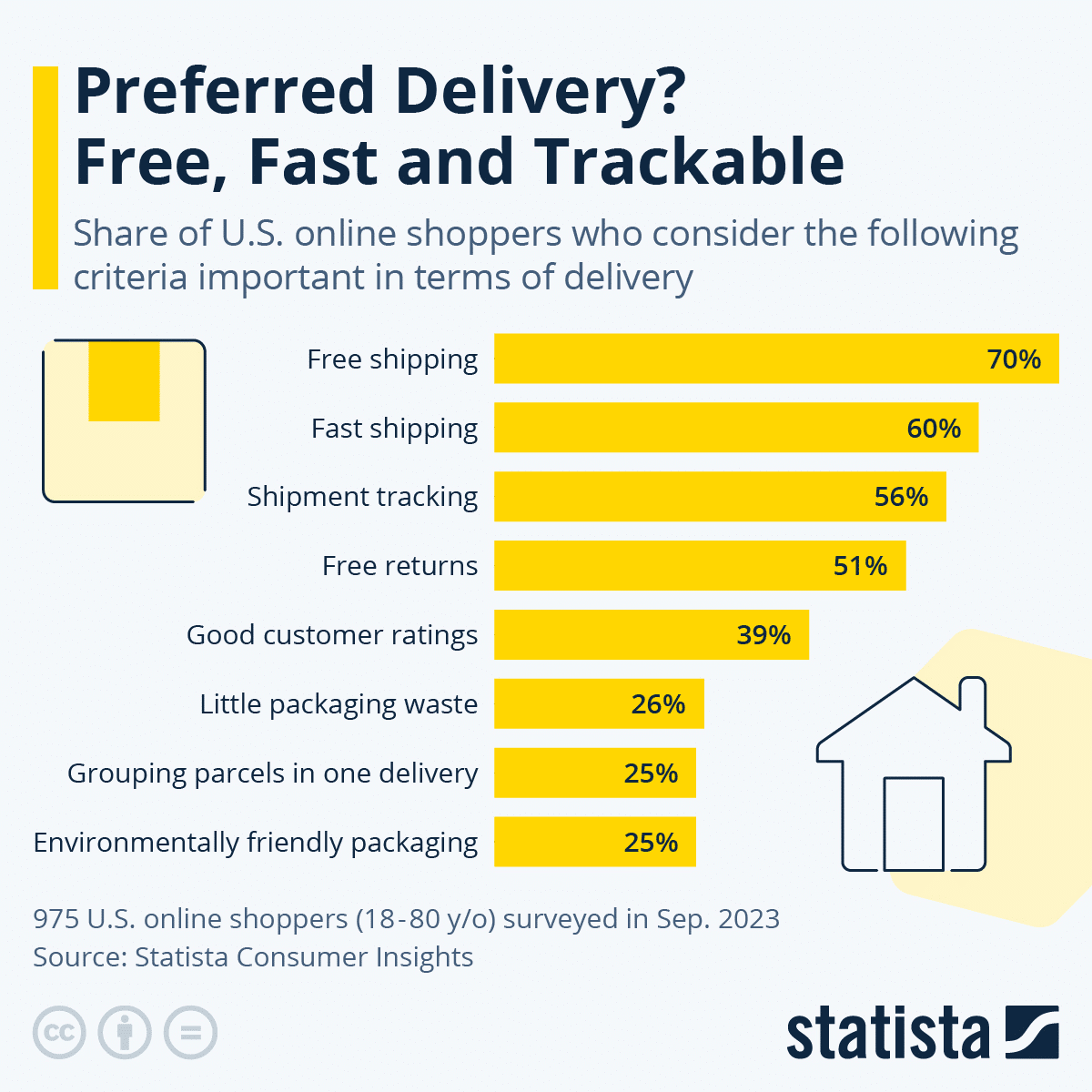
Generic Product Pages
Today, customers want to purchase something that is unique. Therefore, if your product page lacks a description and is flooded with stock images, customers will find it fake.
Poor User Experience
A slow and jittery website leads to an unacceptable user experience and customers are highly likely to abandon such websites, increasing your bounce rates. According to surveys, businesses tend to lose 35% of sales due to poor user experience.
Increase Your Shopify Sales Without Paid Ads
1. Optimize Your Store For SEO
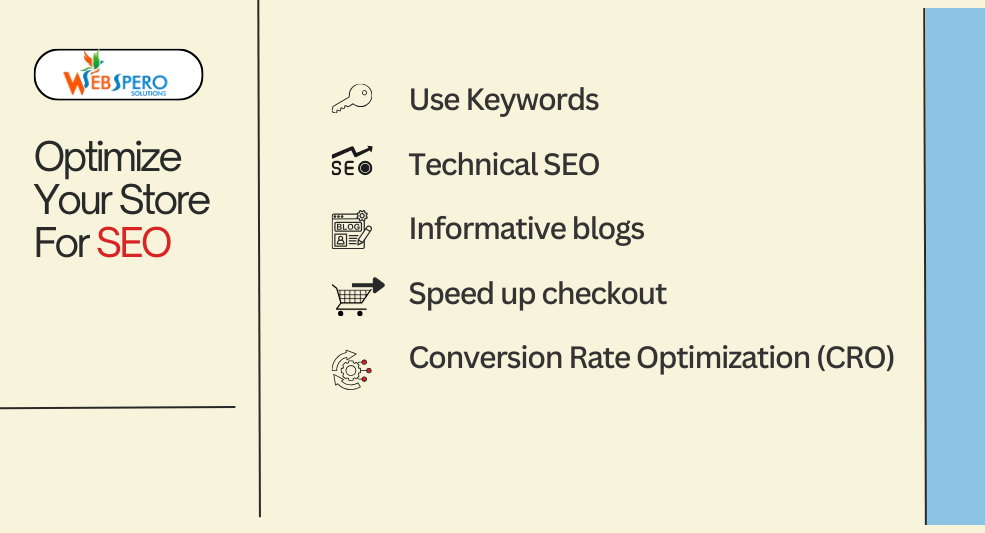
Search Engine Optimization, or SEO, goes a long way to boosting your sales organically.
In fact, it is one of the most effective ways to provide a significant influx to your online store, as you can increase your visibility on search engines like Google and Bing.
Luckily, Shopify provides a lot of apps to improve your SEO, such as Plug-In SEO.
While you can conduct SEO on your own, we recommend you opt for professional Shopify SEO services. Here’s all the necessary aspects you should focus on:
- Use keywords: Make sure you’re including keywords in product titles, descriptions, and meta tags. This will enable search engines to find your store when specific queries are searched. You can use tools like Google Keyword Planner to find relevant keywords.
- Technical SEO: To ensure a seamless user experience, make sure your website is fast, mobile-friendly, and well-structured with clean URLs. Additionally, you need to add alt-texts for images. Speed up your Shopify store with these essential tips.
- Informative blogs: Create high-quality, informative, and relevant content that includes relevant keywords that answer user queries. There’s a high chance the organic traffic will convert into customers if they find your blog useful.
- Speed up the checkout process: Customers do not like to click pages upon pages when making a purchase. If they are already on the checkout page, make this step efficient to ensure your users convert into customers.
- Conversion Rate Optimization (CRO): It is a great way to optimize your Shopify store to attract customers with a high likelihood of converting. Additionally, you can gather quality leads with a well-planned CRO to target them with email marketing.
2. Use Email Marketing
An increasing number of marketers believe that email marketing is not relevant now; however, statistics show otherwise. According to Constant Contact, emails influence approximately 60% of consumers to make a purchase. Therefore, utilize email marketing to boost your Shopify store sales with these steps:
- Create a mailing list: Identify your target audience and collect email addresses from your website visitors. You can also provide incentives to your users to encourage them to subscribe to your newsletter.
- Select an email marketing app: Similar to applications for SEO, Shopify offers apps for email marketing. You can choose whichever aligns with your goals. We recommend Klaviyo.
- Personalize your emails: Don’t go for a one-size-fits-all approach, instead, customize your emails to specific points in the customer journey. Add images and relevant information within the email.
- Promote new products and discounts: Keep your audience updated on new product launches, seasonal promotions, or limited-time offers.
- Include a strong call-to-action (CTA): Always add a clear and compelling strong CTA, which is at most 4 words long, to drive clicks and conversions.
- Write appealing subject lines: Having attractive yet authentic subject lines is necessary to ensure that your users open the emails.
- Conduct A/B test: Always test your emails and compare results to understand what works and works in that direction.
3. Leverage Social Media
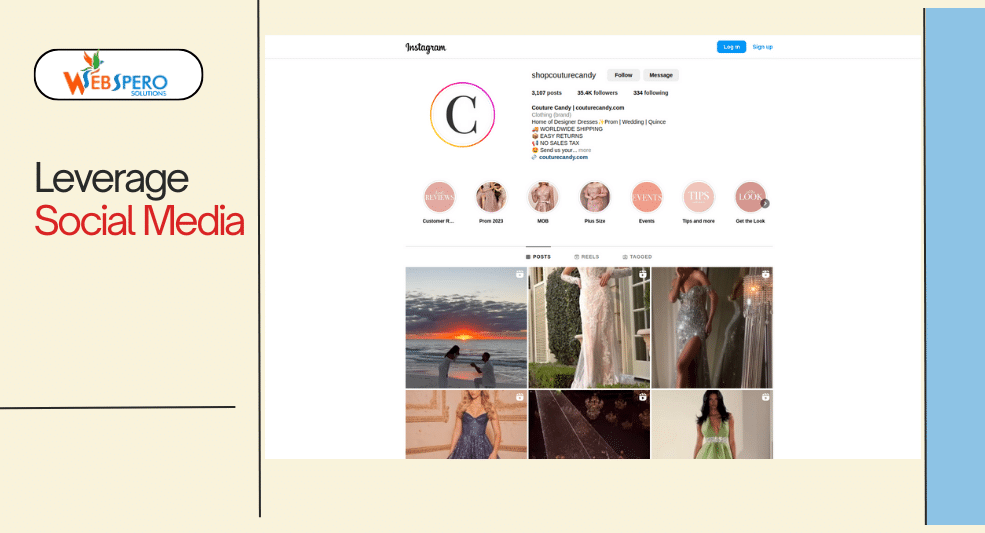
When used effectively, social media can be a significant tool to drive sales. In fact, according to HubSpot, 41% of users find new products on social media in three months.
Also, make sure you’re adding your online store’s link to your social media using Linkpop.
Here are proven tips to help you make the most of your social media:
- Make a business account: Create a social media account that represents your brand style and set it as a business account to build credibility.
- Promote your account: You don’t have to run ads on your social media to increase your reach. Simply share it with your family and friends, asking them to share it forward. While it may not be a lot, but it’s a great starting point to get your brand out there.
- Remain consistent: Create a schedule or social media calendar to ensure that you are delivering quality content consistently.
- User-generated content: Offer your products for free to influencers in exchange for exposure. Additionally, encourage your customers. to post pictures of your products and share them on social media, tagging you.
- Conduct contests: Consider running contests on your social media, offering discounts and freebies. It will not only boost your sales but also increase your social engagement.
- Ask questions: Social media platforms are excellent tools to communicate with your users and ask them the pros and cons of your products from a user perspective and their experience with it.
By acting on the provided feedback, you can serve your customers better, improving your sales.
4. Use Promotional Pop-ups
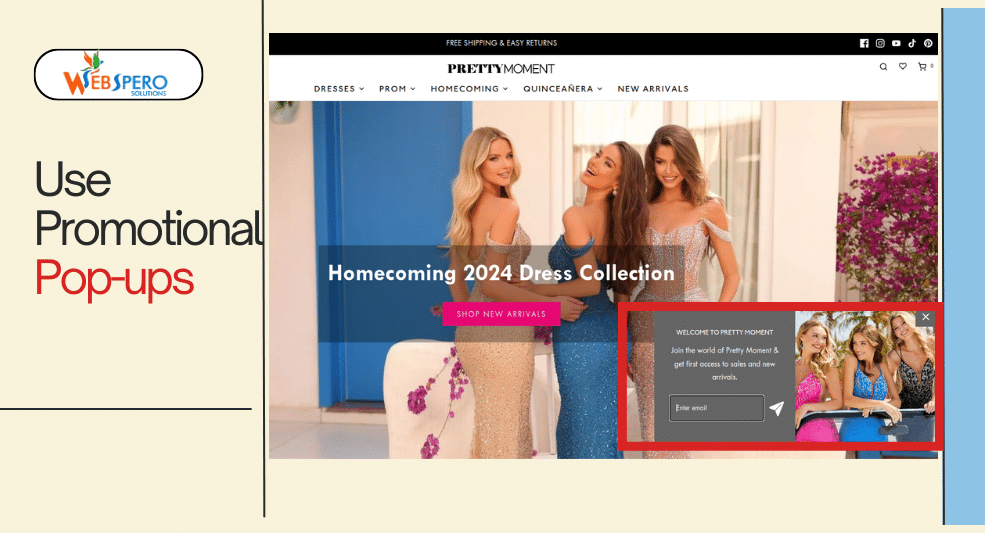
Promotional pop-ups can be used to notify customers of the latest offers or attract new customers. Interestingly, the average click-through rate (CTR) for pop-ups is 7.09% on desktop and 10% on mobile devices.
Our top tip is to have people subscribe to your mailing list in exchange for a discount. You can either use Shopify’s inbuilt form feature or a third-party app to create pop-ups. Here’s a quick guide on how to add pop-ups to Shopify using Wisepops, a third-party app:
- Step 1: Add the Shopify pop-up app to your store
- Step 2: Open the app and fill in your details
- Step 3: Click on the pop-up section and then create a campaign button
- Step 4: Choose a template from the template library
- Step 5: Customize the campaign as per your needs: Images, CTA, and more
- Step 6: Configure the pop-up display scenario (when you want the pop-up to trigger, i.e., when users land on the page, on scroll, and more)
- Step 7: Sync your email app to ensure all the email addresses end up in your email app
- Step 8: Finally, activate your Shopify pop-up to make it go live.
| NOTE: Test it once to ensure it is working properly. |
5. Leverage Push and On-site Notifications
Whether you’re using push notifications or on-site notifications, these are excellent tools to inform your users about the latest discounts and promotions.
Push notifications are specifically impactful for mobile users because 65% of users tend to return to the app when push notifications are enabled.
However, try not to overdo it because repeated and non-essential notifications can make users delete the application.
As for on-site notifications, they are simple, don’t really interfere with the user experience, and provide information on new offers in a more indirect manner.
6. Add a Loyalty Program
Loyalty programs are a great way to retain loyal customers and convert one-time buyers into loyal customers. This is important because loyal and repeat customers account for 40% of businesses’ annual sales.
Luckily, Shopify offers a lot of applications to create the ideal loyalty program for your store. We recommend Rivo Loyalty, as it is easy to use and works with the latest Shopify themes.
7. Add User Reviews
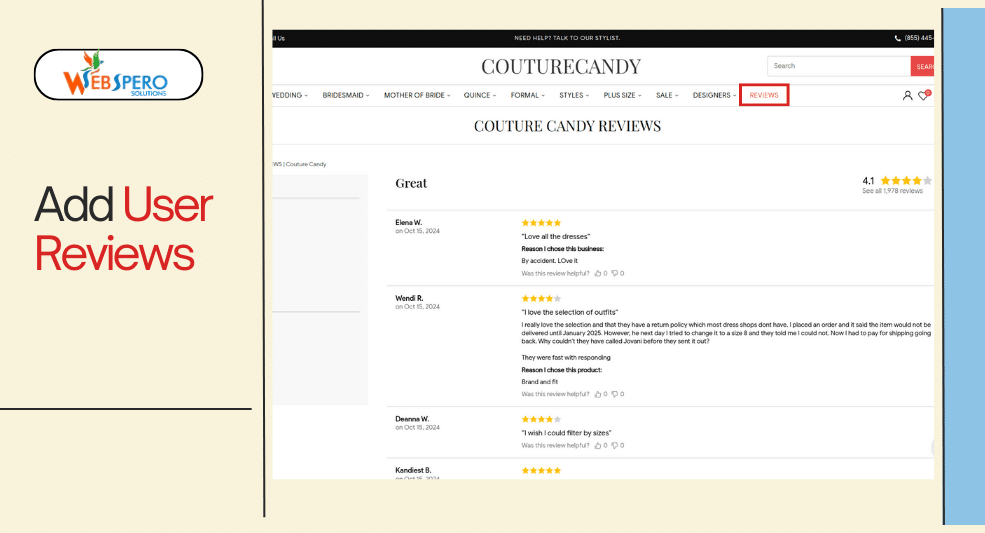
Testimonials go a long way when it comes to building credibility and boosting sales. Make sure to add genuine customer reviews and ratings to your product pages as well as checkout pages.
You can also incentivize users to provide feedback by offering them discount or points, further adding to the loyalty program. Once again, Shopify understands this very well and offers many applications like Judge.me to add reviews functionality.
8. Integrate Live Chat
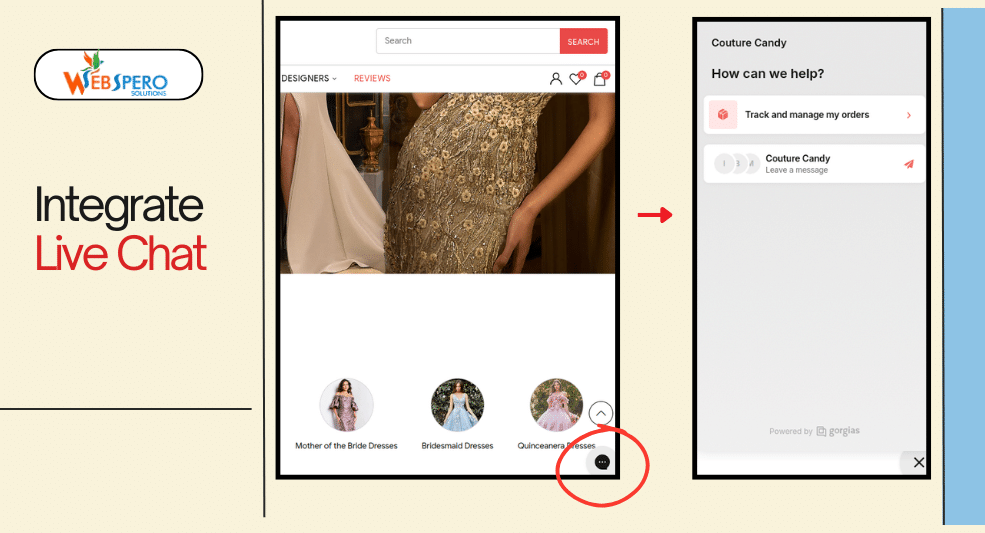
According to Freshworks, businesses with a live chat option see a 20% increase in conversions.
Thankfully, it is very easy to integrate live chat options on your Shopify store. Here’s how to do it:
- Go to the Shopify admin dashboard
- Click on Add apps
- Search “Live chat” and select an app like Shopify Inbox
- Then, Install the app
- Configure it: Default message, chat bubble icon, and more.
- Simply click Save, and that is all.
9. Write Informative Blogs
Content marketing is a great way to attract potential customers to your business without paying for ads. However, this doesn’t mean you can post any kind of content and expect traffic. The ideal blog content on your online store should either solve a problem, answer user queries, explain how a product works, or give value to your customers.
Additionally, it also helps with SEO. Here’s how to add a blog post to your Shopify account:
- Open your Shopify dashboard and go to the Online Store Section
- Click on Blog Posts and then Create a Blog post
- Write a title and blog content and add appropriate images
- Then, from the Blog drop-down menu (right of the screen), choose create a new blog
- Once you’re done, click save
10. Add Trust Signals
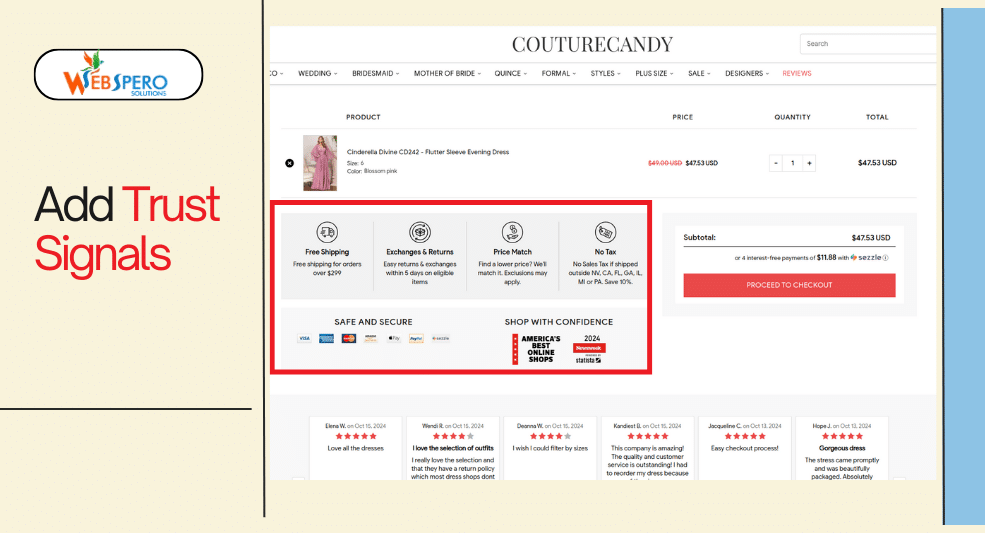
New customers often struggle to trust new online stores, leading to abandoned carts. This is why it is crucial to add trust signals to your online store, especially on the checkout page.
- Money-back guarantees
- Customer reviews
- Return/refund policies
- SSL certificates (default on Shopify)
- Logos of credit card processors
Here, the trust signals act like a safety blanket for users, ensuring they complete their purchase.
11. Provide Accessible Customer Support and Return Policy
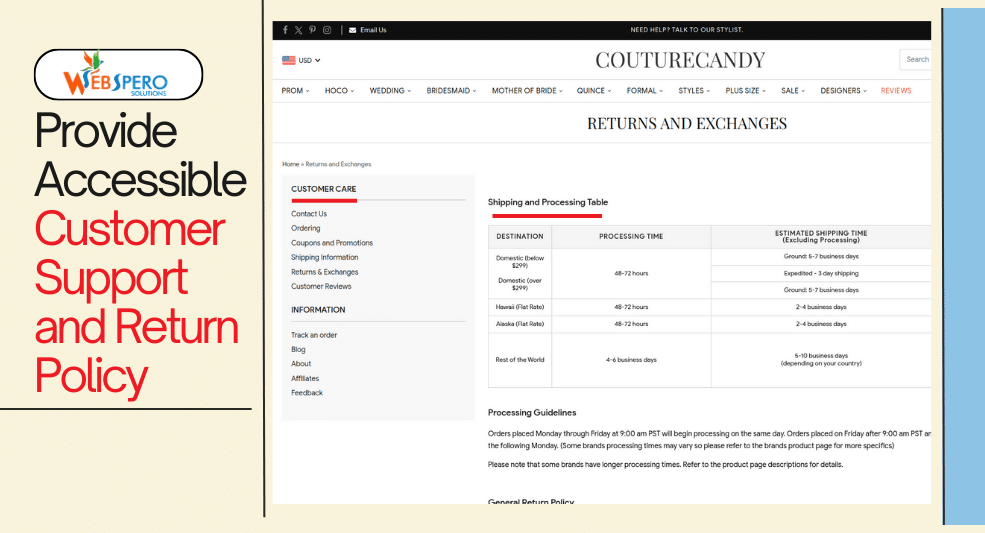
Having accessible contact information and customer support is crucial when it comes to providing the ideal customer experience. This gives a sense of security to your customers that they will not be abandoned after they make a purchase, increasing your customer retention rates and sales.
Also, make sure your return policy is easy to find. While it may sound counterintuitive to tell customers how to return a product when it comes to increasing sales, many people check the return policy before making a purchase. When creating a return policy, make sure you highlight the essential information:
- Items/products that can and cannot be returned
- Does the refund come at an additional cost, or is it free?
- How long does it take to return the product
- What is the deadline to make a return
- What quality/state of the product should be in before making a return
| NOTE: It is also a good idea to add a return policy at the checkout page or below the product description. |
Conclusion
Running paid ads is a sure way to attract a significant amount of customers to your Shopify store; however, it does not mean that it is the only way to boost your Shopify sales.
With these tips, you can increase sales at your Shopify store without paid ads. Granted, it will take some time and you have to be consistent with these tips.
If you time is an issue, you can try running ads on a budget or the best option, consult a profession Shopify agency.
Frequently Asked Questions (FAQs)
How can I increase my Shopify sales for free?
You can significantly increase your Shopify sales with:
- Search Engine Optimization (SEO)
- Email marketing
- Social media presence
- Promotional notifications and pop-ups
- Creating a loyalty program
- Adding trust signals
- Providing free shipping and an easy return policy
Does free shipping actually increase the number of sales?
Yes, it is proven by statistics, and many marketers claim that free shipping increases sales.
What are some pros and cons of using paid ads?
Here are some advantages and disadvantages of using paid advertising for Shopify:
Pros:
- Provides measurable results for businesses in a relatively short duration
- Increased brand recognition and conversion rates
- Offers more targeting opportunities
Cons:
- High cost of acquisition cost (CAC) due to increased language
- Inaccurate new privacy laws limiting gathering data
- A growing number of consumers (70-80%) ignoring paid ads
What is a good number of sales for a Shopify store?
There is no specific answer to this question, as there are a lot of factors that dictate this number, such as the size of your store, the amount of traffic, and more. However, conversion rate (CVR) is a good point to consider.
A good CVR is anywhere between 2.5% and 3%, and if it is under 0.5%, it is considered a poor sales number.
Here’s how to calculate the conversion rate:
Conversion rate = Total number of converted users/overall audience size x 100%
How long before I can see a boost in my Shopify store with these tips?
It totally depends on how effectively you implement these tips, and once again, it will depend on the size of your store, how long you’ve been in business, and more.
But you can expect measurable results anywhere from 4 to 6 months.
Can I increase my Shopify sales on my own, or do I need professional help?
While you can certainly work with these tips to boost your sales, having professionals take over your online store will get you steady results. At WebSpero Solutions, our Shopify SEO experts will boost your sales with measurable results.
